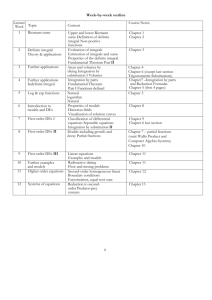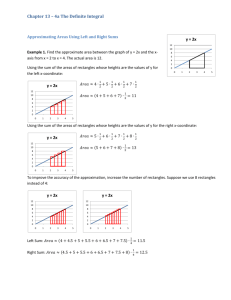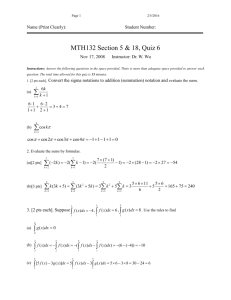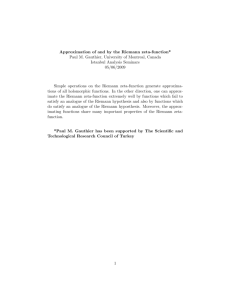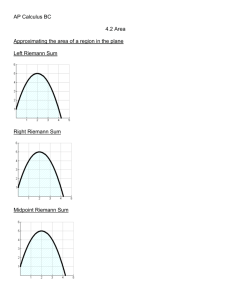Recognising Riemann Sums A Dialogue Someone told me that lim
advertisement
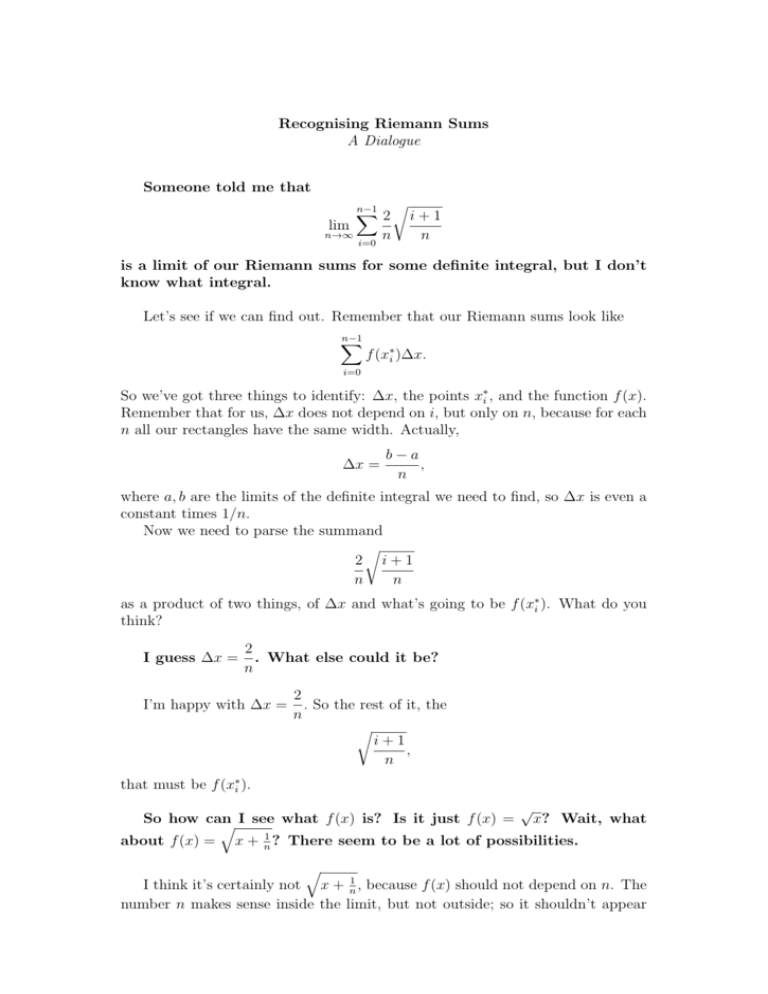
Recognising Riemann Sums A Dialogue Someone told me that n−1 X 2 lim n→∞ n i=0 r i+1 n is a limit of our Riemann sums for some definite integral, but I don’t know what integral. Let’s see if we can find out. Remember that our Riemann sums look like n−1 X f (x∗i )∆x. i=0 So we’ve got three things to identify: ∆x, the points x∗i , and the function f (x). Remember that for us, ∆x does not depend on i, but only on n, because for each n all our rectangles have the same width. Actually, ∆x = b−a , n where a, b are the limits of the definite integral we need to find, so ∆x is even a constant times 1/n. Now we need to parse the summand r 2 i+1 n n as a product of two things, of ∆x and what’s going to be f (x∗i ). What do you think? I guess ∆x = 2 . What else could it be? n I’m happy with ∆x = 2 . So the rest of it, the n r i+1 , n that must be f (x∗i ). √ So how can q I see what f (x) is? Is it just f (x) = x? Wait, what about f (x) = x + n1 ? There seem to be a lot of possibilities. q I think it’s certainly not x + n1 , because f (x) should not depend on n. The number n makes sense inside the limit, but not outside; so it shouldn’t appear in our definite integral. All of the remaining dependence on i and on n in our summand has to be captured in the “x∗i ” part, not the f (x) part. √ OK, how about f (x) = x then? Which I guess would mean x∗i = i+1 . That sorts out all right. n That’s what it would mean, yeah. Let’s see if that’s reasonable. We can compute the limits b and a of the definite integral if we know a formula for x∗i . That’s because lim x∗0 = x0 = a n→∞ and lim x∗n−1 = xn = b. n→∞ Wait, why? Remember that x∗0 is some point between a = x0 and the next partition point x1 = x0 + ∆x. Since ∆x goes to zero as n goes to infinity, that x∗0 has nowhere to go but to x0 . Likewise, the points x∗n−1 are all within ∆x of the right endpoint b = xn , so they tend toward b. 1 n+1 I see. So if x∗0 = then a = 0, and if x∗n−1 = then b = 1. But n n wait, didn’t we say that b − a = 2 before? That’s not what we have here. That’s right, we’re locked into b − a = 2 from our choice ∆x = 2/n. One possibility is that maybe that choice was wrong. Really? How could that be? That’s a good question, but let’s persevere here for the moment. One way to i+1 look at the problem with our try x∗i = is that these points don’t have the n 1 right spacing. They have x∗i − x∗i−1 = . But the width of our partition is larger n 2 than that, it’s twice that, ∆x = . n i+1 I see, so we have two fractions between xi and xi−1 , when n there’s only supposed to be one rectangle there, one x∗i . That’s not right. Hey, should we have x∗i − x∗i−1 = 2 n instead? That certainly has the right spacing. I think that’s a good idea. Actually, remember that for a left or right or midpoint Riemann sum, the points x∗i all have that same spacing ∆x. So if we guessed we were looking at one of those, we should certainly have x∗i − x∗i−1 = ∆x, like you said. Well, if we thought we had a = 0, maybe we’re looking at a right Riemann sum, which would have x∗i = 2i+2 . Then we’d have each x∗n−1 = n 2. So we’d have b = 2, which gives b − a = 2 like we were supposed to. But now what’s f (x)? If x∗i 2i + 2 = and f (x∗i ) = n r i+1 , it looks like f (x) = n r x . 2 Wait, how’s that? We can write r r 1 2i + 2 1 ∗ f (x∗i ) = = x. 2 n 2 i Then we should get f (x) just by replacing x∗i with x. All right. So, putting it all together, I think we get r Z 2r n−1 X 2 i+1 x lim = dx. n→∞ n n 2 0 i=0 If you like, you can test it out, by writing down Riemann sums for that integral. I think you’ll get exactly what we started with! OK, that’s good. But I’m not sure I understand, is this the only definite integral that answers the problem? Could we have two definite integrals that look different but give the same Riemann sum? No, it’s not the only definite integral that works! If you remember, we made two choices that weren’t forced: we took ∆x = 2/n and we took a = 0. Oh. But those look just obvious. They sure do! And they answered the question, so they did all right in the end. But wait, what if in some other problem the obvious choices were wrong? Actually, those ones can’t be wrong. But we did have to make sure that our formula for x∗i was compatible with them. Wait, what? Can’t be wrong? How does that go? Let’s try making some other choices. Say I want ∆x = 1/n instead. That would make finding x∗i easier, wouldn’t it? All right, so b − a = 1 then. And I further decree that a = 3, so b = 4. Decree? Math is like painting – it’s your world, do what you want. As long as what you want is logically consistent, anyway! Uh. That’s really funny. So you were saying we can actually write down another definite integral with the same Riemann sums? i+1 We sure can. I’m going to take x∗i = 3 + . That 3 is there because I n need x∗0 to go to a = 3 as n goes to infinity. And then I’m going to take √ f (x) = 2 x − 3. So the factor 2 in our sum went into f (x) instead of ∆x. Altogether, I get r Z 4 n−1 X √ 2 i+1 = 2 x − 3 dx. lim n→∞ n n 3 i=0 You can check that it works out if you want. So that’s another integral with the same Riemann sum. That’s really weird. There’s a good explanation for it, actually. The two integrals we wrote down are related by a substitution, 1 x 7→ x − 3. 2 The integrals have the same Riemann sums because this substitution is a linear change of co-ordinates. You could make any such change of co-ordinates; but once you specify ∆x and a, or a and b, everything else is determined: there are no more choices. What’s a substitution? We’re going to talk about it in a week or so. The short answer is that it’s the integration version of the chain rule for differentiation. The longer answer is – wait for later, I guess! I’m still confused. That’s natural. I’m confused every day. It’s what happens when you try to push the bounds of your knowledge. If you understood it all right away, it wouldn’t be new knowledge. Anyway, a good thing for confusion often is to work out some examples. So you can pick up a textbook and choose some integrals, and try to write those as limits of Riemann sums; or you can get someone to give you some limits of Riemann sums and try to write down the integral. Then you’ll get used to it. Although, maybe you can get used to it and still be confused. Hey, I’ve got just one more question. We made one more arbitrary choice than that, didn’t we? I mean when we decided that our sum should be a right Riemann sum. What if it’s not? How would I know? Well, the problem wasn’t randomly generated – someone made it, so they made it this way. There are certainly a lot more Riemann sums than left, right, and middle, but you’re not going to see them as much. You can write some down easily, like r n−1 X 2 i + sin2 (i3 ) , lim n→∞ n n i=0 which is a Riemann sum for the same definite integral we had. What is that monstrosity? Just something mathematicians like to do, to write down strange examples. Don’t worry about it. It won’t be on the quiz. Problems on a quiz are made to be solved. I hope it won’t. Well... all right, I won’t worry.


